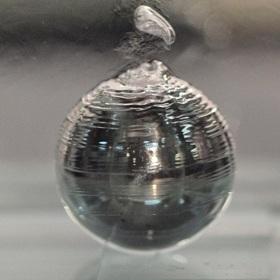Understanding longevity: From gene sequences to social inequity
03 April 2025
Published online 3 July 2011

If water is poured on a hot metal plate above 100°C, it will skate across the surface rather than begin to evaporate. According to the 225-year-old Leidenfrost effect, a liquid produces an insulating vapour layer when it comes in contact with a solid surface that is hotter than its boiling point: known as the Leidenfrost point. Two researchers decided to take on this phenomenon and published their results in Physical Review Letters last month.
Ivan Vakarelski, a chemical engineer at King Abdullah University of Science and Technology (KAUST), Saudi Arabia, and Derek Chan, a professor of mathematics at the University of Melbourne, Australia, decided to see what happens in reverse: they dropped hot metallic spheres into a fluorinated liquid with a boiling point of 56°C.
"This makes it easier to initiate the 'inverted' Leidenfrost effect — a thin film of vapour covering the metal," explains Vakarelski. Just as the vapour layer moves liquid across the surface of a hot plate, it allows for faster movement of the spheres through the liquid. "We thought that this could be the perfect system to model the drag reduction by [the] vapour layer," he adds.
Research had demonstrated the reduced hydrodynamic drag that vapour layers can have on objects moving through liquids. Vakarelski says their study is the first measurement of the limit of drag reduction a vapour layers can produce. "We showed that the Leidenfrost vapor layer can reduce the drag on a sphere by up to 85%."
Possible uses
Any object moving through a fluid experiences drag, or resistance. The drag coefficient, the measure of an object's drag, of the vapour-encased sphere reduced from 0.4 to 0.07, a change of 571%.
These findings could help engineers optimize liquid flow through pipes and make microfluidic devices more efficient, says Vakarelski. It can also be applied on a larger scale, such as in shipping or submarines.
A reduced drag could save energy and reduce carbon emissions. "For ships or high-speed underwater vehicle achieving even 10% or 20% percent would be a substantial result," says Vakarelski.
The research is fundamental and it will take a few more years before findings can be commercially applied though. Vakarelski hopes that devices exploiting the Leidenfrost effect could be ready for testing in a couple of years. "Our focus is on the formation and sustainability of bubble layers in water which will bring us closer to practical applications. We hope that this next stage will be completed before the end of this year."
Alaa Ibrahim, an astrophysicist at the University in Cairo (AUC) says the research is original and of great value to the industry. Ibrahim also envisages application of the technology in shipping. "However, you will have to spend energy to heat up the surface of the moving body and this in itself opens up another interesting research investigation to minimize the energy consumption and safely insulate the cargo."
doi:10.1038/nmiddleeast.2011.81
Stay connected: